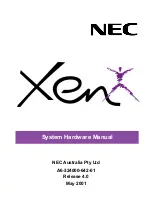
2 - 56
Chapter 2
Chapter 2 - Blade Installation and Startup
2.6.3
Gigabit Ethernet PoE Switch (GSWU) (Figure 2-27
) - P/N 0911066
The GSWU blade is a managed 8-port gigabit ethernet PoE switch.
The GSWU blade provides:
●
8 Gigabit Ethernet (10/100/1000) Ports
●
Status LEDs Indicating Link, Speed and Activity
●
802.3af PoE on All Ports Providing up to 15.4W of Power
- Selectable level per port via web-based management interface
●
Auto-MDI/MDI-X Auto Crossover (when auto-negotiation is available)
●
Basis Layer 2 Switch Management
●
QoS
●
802.1Q VLANs
●
802.1p Priority Queuing
●
Port Mirroring
●
802.3x Flow Control
●
Independent VLAN Learning Support
●
TCP/IP Networking Stack
●
Multi-Unit Stacking (multiple blades in a system are managed from the same user interface)
●
Dynamic PoE Control (allows setting the proper PoE classifications for each port to stay within the
system power budget)
●
Switch Management Through Web-Based GUI
●
Software Upgrades Via TFTP
Ports 1 and 8 are the default “uplink” ports. All the user management and stacking is based on this setup.
Multiple-Unit Stacking allows the user the ability to manage multiple GSWU blades in a system as one switch,
instead of individual units and IP adresses. For example, a set of 3 blades would appear to the user interface
as a 24-port switch, instead of 3 8-port switches. Stacking works by assigning a Main Management Blade,
which will provide all the GUI information for all blades in the same stack. The CCPU assigns the Main blade
by issuing an IP address to the Main blade via PAW/PRW during initialization sequence. All other GSWU
blades detected in the system will not be assigned an IP address, thereby signifying them as “add-on” blades.
A single UX5000 system can have up to 12 GSWU blades per system. However, only 3 GSWU blades can be
grouped together to form a single 20-port switch. When more than 3 GSWU blades are present within a
system, the blades not grouped together will not have any of the software feature of the stacked blades. They
will behave as an unmanaged gigabit ethernet switch (only eight 10/100/1000 ethernet ports and PoE Class 3
[lowest power class]). The 2 GSWU blades can be categorized into one “Main” blade, with 2 additional “Add-
on” blades.
Summary of Contents for UX5000
Page 12: ...x Table of Contents Table of Contents...
Page 18: ...1 6 Chapter 1 Chapter 1 Installing the Chassis...
Page 26: ...1 14 Chapter 1 Chapter 1 Installing the Chassis...
Page 84: ...1 72 Chapter 1 Chapter 1 Installing the Chassis...
Page 90: ...2 4 Chapter 2 Chapter 2 Blade Installation and Startup...
Page 98: ...2 12 Chapter 2 Chapter 2 Blade Installation and Startup...
Page 113: ...Chapter 2 Blade Installation and Startup Chapter 2 2 27 Figure 2 11 EXIFU CABLING...
Page 144: ...2 58 Chapter 2 Chapter 2 Blade Installation and Startup...
Page 172: ...2 86 Chapter 2 Chapter 2 Blade Installation and Startup...
Page 174: ...2 88 Chapter 2 Chapter 2 Blade Installation and Startup...
Page 208: ...4 14 Chapter 4 Chapter 4 Terminals and Optional Equipment...
Page 212: ...4 18 Chapter 4 Chapter 4 Terminals and Optional Equipment...
Page 220: ...4 26 Chapter 4 Chapter 4 Terminals and Optional Equipment...
Page 222: ...4 28 Chapter 4 Chapter 4 Terminals and Optional Equipment...
Page 224: ...4 30 Chapter 4 Chapter 4 Terminals and Optional Equipment...
Page 226: ...4 32 Chapter 4 Chapter 4 Terminals and Optional Equipment...
Page 228: ...4 34 Chapter 4 Chapter 4 Terminals and Optional Equipment...
Page 254: ...4 60 Chapter 4 Chapter 4 Terminals and Optional Equipment...
Page 260: ...4 66 Chapter 4 Chapter 4 Terminals and Optional Equipment...
Page 274: ...4 80 Chapter 4 Chapter 4 Terminals and Optional Equipment...
Page 284: ...5 4 Chapter 5 Chapter 5 LAN Connection...
Page 332: ...vi Index Index...
















































